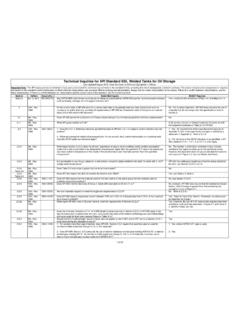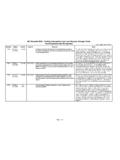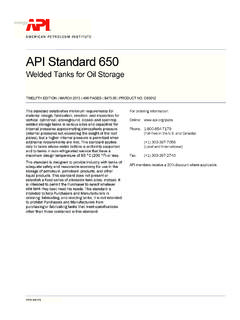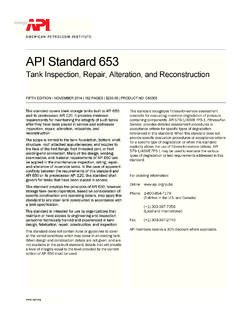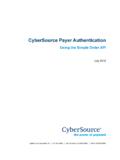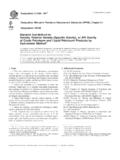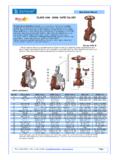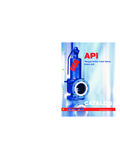Transcription of The installation of an aluminum internal floating …
1 PORTTECHNOLOGYINTERNATIONAL1 DANGEROUS ANDHAZARDOUS MATERIALSThe perimeter is configured with a double wiper seal. This tankequipped with this AIFR would become efficient. of the emissions would be lost to the atmosphere. Theemissions lost without the AIFR are 1,499,403 lbs. per year. Theemissions lost with the AIFR are only 4,960 lbs. per year. Using6 lbs per US gallon, the 1,494,443 lbs, saved equates to 249,074gallons. Applying 82 cents per gallon, (the current spot price forHouston gasoline), the savings realised is 204,240 $US, (Eur166,638). The cost to install a Skin and Pontoon AIFR in thistank in Houston is less than one half of the realised savings. Thatmeans the investment pays back in less than six months. The differences in design, fabrication and installationvary widely between manufacturers of both non-contact and full-contact AIFRs.
2 These may not be obvious to those who are not regularly involved with the details of AIFRs, but understanding the differences is necessaryto the purchase of a reliable and quality calculations are based on the US EnvironmentalProtection Tanks 4 program, which is the standard method forcalculating emissions losses for permitting and enforcement purposesin the USA. See the US EPA web site: ap42 for information and addition to lower emissions and increased profitability,AIFRs also improve safety by reducing the risk of fires andexplosion. Contamination is eliminated since rain water, airborneparticles and scale are kept out of the product. AIFR designs have been in service for almost 40 years. Theoriginal design consisted of pillow floats and skin decks whichevolved into a foam-filled rectangular pontoon design tocompensate for insufficient buoyancy and strength.
3 This designhad short-comings related mostly to failed deck seam sealants andbuoyancy shortfalls. Continuing evolution has brought us to the two modern AIFR designs. These two designs arefundamentally different in that one maintains a saturated vapourspace above the liquid surface while the other is in full contactwith the full liquid surface and has no vapour space. The mostwidely used non-contact design is the Skin and Pontoon type,while the full-contact variety is known as the Honeycomb (HC)design. The Skin and Pontoon type is typically composed of asystem of interconnected hollow tubular aluminum pontoonssurfaced with a grid of aluminum beams and HC AIFR, of which the original version was introducedabout 25 years ago, is constructed of a series of flatABSTRACTThe installation of an aluminum internal floating roof(AIFR) in a fixed roof petroleum or petrochemical tankis a sound business decision, benefiting the environmentwhile increasing profitability.
4 The environmental benefit isa reduction of harmful emissions by a minimum of 95%,depending on several factors which will be detailed in thisarticle. Profitability is increased due to the savings ofstored product from emission loss. As an example, let slook at a fixed roof tank, 120 feet ( ) in diameter by48 feet ( ) high, located in Houston, Texas, USA. We llassume the product service is motor gasoline with a ReidVapour Pressure of 10 psi. The tank has a steel fixed domeroof and experiences 36 turnovers per year. The AIFR iscable suspended in lieu of fixed or two position supportlegs. (Cable suspension will be discussed in more detaillater in this article). The installation of an aluminum internalfloating roof is a sound investmentBill Grimes, ALLENTECH, Bethlehem, PA, USAF igure 1.
5 Skin and Pontoon type plan 2. Honeycomb core and skins shown at panal OF ALLENTECH interconnected composite modules consisting of a honeycombhex core sandwiched between aluminum differences in design, fabrication and installation varywidely between manufacturers of both non-contact and full-contact AIFRs. These may not be obvious to those who are notregularly involved with the details of AIFRs, but understandingthe differences is necessary to the purchase of a reliable andquality excellent starting point would be to become familiar withthe American Petroleum Institute (API) Publication 650, AppendixH. API s home page is , while a catalogue ofpublications is at 650 is the industry standard that promotes adequate safetyand reasonable economy regarding the material, design,fabrication, and erection, and testing of above-groundpetrochemical storage tanks.
6 Appendix H provides the minimumrequirements that apply to the floating roof of a tank with a fixedroof. The three key words here are: adequate, reasonable andminimum. Appendix H is intended to limit only those factorsthat affect safety and durability. For this reason it is prudent tolook to and beyond API when selecting an AIFR supplier. The differences in design between the Skin and Pontoon andthe HC AIFR are dramatic and so is the cost difference. The Skinand Pontoon IFR is the most economical design available and can usually be delivered more quickly than the HC , installs Skin and Pontoon roofs in one day per10 feet of tank diameter once the shop fabricated components aredelivered to the worksite, while our HC variety can normally beinstalled in even less time. There is no door sheet or otheropening required for the Skin and Pontoon type AIFR since allcomponents fit through existing tank shell manways.
7 The HCAIFR requires an opening in either the tank roof or shell. Thereis no expensive and time-consuming hydro-test required foreither quality AIFR can provide a minimum 25 years service life,even when exposed to high fill rates, and frequent cycling. Thefollowing section contains a checklist with my recommendationsfor selecting a quality Pontoon and Skin AIFR. A similar checklist for the HC AIFR will be discussed later in this Select an experienced and reputable manufacturer. Theexperience that comes from designing, fabricating andinstalling AIFRs and providing service and repair to customerswith existing AIFRs gives a company the expertise toconstantly improve their products. Look for a supplier that hasboth in-house engineering and fabrication, with an intimateknowledge of API 650 and 653 and all related standards andregulations.
8 They should be capable of addressing and solvingall problems and conditions related to internal floating Select a manufacturer that will provide an AIFR custom -designed for your tank. Quality and standardisation areachieved by an engineered design that is fabricated in a shopunder controlled conditions. The pre-fabricated componentsare then sent to the field to be assembled from engineereddrawings by trained mechanics. This method will produce ahigher quality product than one that is fabricated in the fieldfrom standard components. In fact, my advice is to avoidAIFRs built with standard components and opt for thosecomposed of pre-fabricated custom extrusions. One of themany benefits of aluminium is that custom shapes can beinexpensively extruded to produce components with far morerigidity and strength then standard shapes.
9 The perimeter especially should be extruded and rolled toaccommodate the circumference of the tank. Some AIFR manufacturers use bent sheet, segmented to approximate acircle. Verify that your supplier conforms to API 650 that Aluminium load-carrying members, assembliesand connections comply with the design requirements of thelatest edition of the aluminum Design Manual: Specificationsfor aluminum Structures, as published by the AluminumAssociation, Inc. (Washington, DC).3. Require a tank shell and column plumbness survey andinspection to be performed or reviewed by the API recommendation, is intended to preventoperational problems. Out-of-round and out-of-plumbconditions, along with tank shell imperfections, can inhibitinternal roof travel and prevent proper functionality ofperimeter roof seals.
10 4. Insist on stainless steel hardware. API, calls foraustenitic type stainless steel or aluminium fasteners. In providinginspection and repair services, we have witnessed AIFR failuredue to galvanic corrosion of plated bolts and Compare structural components. Pontoon length and spacingwill vary between suppliers. Generally, closer pontoon spacingwill provide the best support while the IFR is floating orresting on its supports. Pontoon end cap failure plagued earlyAIFRs. Hence, pontoon end caps should be flanged and filletwelded by certified welders. Additionally ALLENTECH employs brackets which span the full diameter of the pontoonand are welded the full length of the bracket on both sides,then gusseted top and bottom again with seal design will develop the full compression and bendingstrength of the pontoon.
